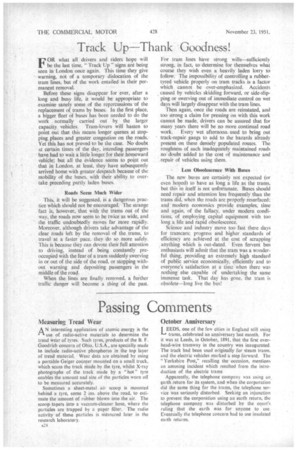Track Up—Thank Goodness!
Page 26

If you've noticed an error in this article please click here to report it so we can fix it.
FOR what all drivers and riders hope will be the last time, " Track Up " signs are being seen in London once again. This time they give warning, not of a temporary dislocation of the tram lines, but of the work entailed in their permanent removal.
Before these signs disappear for ever, after a long and busy life, it would be appropriate to examine sanely some. of the repercussions of the replacement of trams by buses. In the first place, a bigger fleet Of buses has been needed to do the work . normally carried out by the larger capacity vehicles. Tram-lovers will hasten to point out that this means longer queues at slopping places and greater congestion on the roads.. Yet this has not proved to be the case. No doubt at certain times of the day, intending passengers have had to wait a little longer for their homeward vehicle; but all the evidence Seems to point out that in London. at least, they have subsequently arrived borne with greater despatch because of the mobility of the buses, with their ability to overtake preceding partly laden buses.
Roads Seem Mach Wider This, it will be suggested, is a dangerous practice which should not be encouraged. The strange fact is, however, that with the trams out of the way, the roads now seem to be twice as wide, and the traffic undoubtedly moves far more rapidly. Moreover, although drivers take advantage of the clear roads left by the removal of the trams, to travel . at a faster pace, they do so more safely. This is because they can devote their full attention to driving, instead of being constantly preoccupied with the fear of a tram suddenly swerving in or out of the side of the road, or stopping without warning and depositing passengers in the middle of the road.
When the lines are finally removed, a further traffic danger will become a thing of the past. For tram lines have strong wills—sufficiently strong,: in fact, to determine for themselves what course they wish even a heavily laden lorry to follow. The impossibility of controlling a rubbertyred vehicle properly on tram tracks is a. factor which cannot be over-emphasized. Accidents caused by vehicles skidding forward, or side-slipping or swerving out of immediate control on wet days will largely disappear with the tram lines.
Then again, once the roads are reinstated, and too strong a claim for pressing on with this work cannot be made, drivers can be assured that for many years there will be no more continual road work. Everywet afternoon, used to bring out track-repair gangs to add to the hazards already Present on these densely populated routes.. The roughness of such inadequately maintained roads no doubt added to the cost of maintenance and repair of vehicles using them.
Less Obsolescence With Buses The new buses are certainly not expected (or even hoped) to have a§ king a life as the trams. but this in itself is not unfortunate. Buses should need repair and attention less frequently than the trams did, when the roads are properly resurfaced: and modern economics provide examples, time and again, of the fallacy, under modern conditions, of employing capital equipment with too. long a life and rapid obsolescence.
Science and industry move too fast these days for tramcars; progress and higher standards of efficiency are achieved at the cost of scrapping anything which is out-dated. Even fervent bus enthusiasts will admit that the tram was a wonderful thing, providing an extremely high standard of public service economically. efficiently and to everyone's satisfaction at a time when there was nothing else capable of undertaking the same immense task. That day has gone. the tram is obsolete—long live the bus! •












































































